Eugen Schauman
Eugen Waldemar Schauman (Russian: Евгений Владимирович Шауман, Evgeny Vladimirovich Shauman; May 10 [O.S. 22] 1875 – 16 June [O.S. 4] 1904) was a Swedish speaking Finnish nationalist and nobleman who assassinated the Governor-General Nikolai Ivanovich Bobrikov.
Eugen Waldemar Schauman | |
|---|---|
Евгений Владимирович Шауман | |
 | |
| Born | May 10 [O.S. 22] 1875 |
| Died | 16 June [O.S. 4] 1904 (aged 29) Helsinki, Grand Duchy of Finland, Russian Empire |
| Resting place | Näsinmäki Graveyard, Porvoo |
| Nationality | |
| Occupation | Civil servant |
| Known for | The assassination of the Governor-General of Finland, Nikolay Bobrikov |
| Relatives | Waldemar Schauman, father Sigrid Schauman, sister |
Schauman's life
Eugen Schauman was born to Swedish-speaking Finnish parents Fredrik Waldemar Schauman, a general-lieutenant in the Imperial Russian army, a Privy Councillor and senator in the Finnish Government, and Elin Maria Schauman in Kharkov, Russian Empire (now Kharkiv, Ukraine). His brother Rafael was born in 1873 and his sister Sigrid in 1877.[1]
Schauman's patriotism is rumoured to have been awakened in his childhood when his mother used to read him The Tales of Ensign Stål by Johan Ludvig Runeberg. The tales were combined with his yearning for home since the family was forced to travel because of his father's work.[1]
Before the assassination Schauman worked as a clerk in the Senate of Finland. Schauman also arranged a series of marksmanship courses for local students in Helsinki. These courses later became a part of the White Guards.
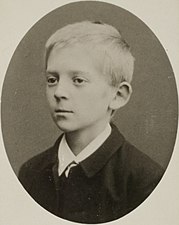 Young Schauman in 1885–1890
Young Schauman in 1885–1890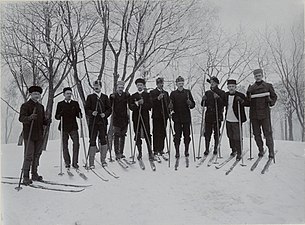 Nylands Nation gathering names for the Great Petition in 1899 (Schauman fourth from the right)
Nylands Nation gathering names for the Great Petition in 1899 (Schauman fourth from the right)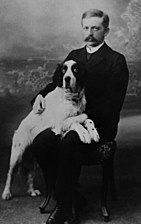 With his dog Lucas in 1904
With his dog Lucas in 1904
Assassination

The assassination of Bobrikov was a topical question among the Finnish activists of the time. Other activist groups are known to have planned an assassination but Schauman convinced them to give him two weeks before they would intervene.[1]
When Bobrikov came to the Senate house on 16 June, Schauman shot him three times, and then himself twice in the chest, using a FN Browning M1900 pistol.[2] Schauman died instantly. Two of the bullets that hit Bobrikov ricocheted off his decoration, but the third bounced back from his buckle and caused severe damage to his stomach. Bobrikov didn't die immediately but was taken to the Helsinki surgical hospital. Surgeon Richard Faltin attempted rescuing his life, but Bobrikov died in the night.[3][1][4]
Aftermath
Schauman left a letter in which he stated that he justified his actions as a punishment for Bobrikov's crimes against the people of Finland. He addressed the letter to the Tsar and wanted him to pay attention to the problems in the whole of the Russian empire, especially in Poland and the Baltic Sea region. He also claimed he had acted alone and emphasized that his family was not involved in the assassination.[5]
Schauman's body was taken to an unmarked grave in the Malmi cemetery in Helsinki. After the political situation eased up he was reburied in the Schauman family grave in the Porvoo cemetery and a monument was built on the grave.
Schauman's legacy
Schauman became something of an icon for the resistance to Imperial Russia and many Finns still consider him a hero. His fame can be characterized by his ranking as the 34th greatest Finn of all time in the 2004 Suuret suomalaiset (Greatest Finns) television poll. In the place of the assassination in the hallway of the Council of State there is a memorial plaque that states Se Pro Patria Dedit ("Given Himself for His Country"). Jean Sibelius composed the funeral march In Memoriam in memory of him.[6] However modernly there has been questioning of his actions, with some raising the view that he was a simple terrorist.[7][8][9]
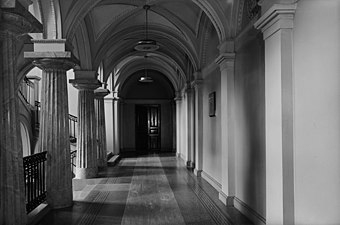 Second floor level of the staircase in the Government Palace, with a plaque on the right observing the spot
Second floor level of the staircase in the Government Palace, with a plaque on the right observing the spot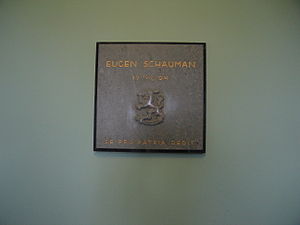 The plaque
The plaque
References
- Niinistö, Jussi (11 October 2000). "Schauman, Eugen (1875 - 1904)". Kansallisbiografia. Retrieved 29 June 2020.
- Gunwriters' Handloading Subsonic Cartridges, Part 2, P.T. Kekkonen, 1999. Accessed on 12 May 2011.
- Järvenpää, Eeva (17 March 2007). "Lahjakas kirurgi yritti pelastaa Bobrikovin". Helsingin Sanomat. Retrieved 29 June 2020.
- "KORJAUS: Uutinen Suomen kenraalikuvernöörin ampumisesta levisi nopeasti aina Honolulua myöten". Keskisuomalainen. 19 October 2019. Retrieved 29 June 2020.
- "Schaumanin kirje". Helsinki. Retrieved 29 June 2020.
- "Other orchestral works / In Memoriam". Jean Sibelius. Finnish Club of Helsinki. Retrieved 2017-12-07.
- Toivonen, Hannu (20 September 2015). "Eugen Schauman: Sankari vai terroristi? Mikä Olli Immosen idoli oli miehiään?". Seura. Retrieved 29 June 2020.
- Kangassalo, Olli (29 January 2019). "Isänmaallisuuteen liitetty aihe tulkitaan rankasti uudelleen Aktivistit-tv-sarjassa – Eugen Schauman ja kumppanit olivat surkeata sakkia". Yle. Retrieved 29 June 2020.
- Nieminen, Tommi (1 December 2019). "Eugen-sedän teko". Helsingin Sanomat. Retrieved 29 June 2020.
External links

- Centennial article about the assassination in Helsingin Sanomat international edition, 15 June 2004